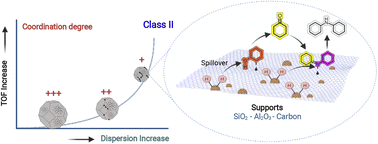Reductive amination of phenol over Pd-based catalysts: elucidating the role of the support and metal nanoparticle size†
Abstract
The heterogeneously catalyzed reductive amination of phenolics from lignin is considered an attractive sustainable route for the synthesis of primary or high-order aromatic and aliphatic amines. Here, the reductive amination of phenol with cyclohexylamine was studied, and insights into the role of the catalyst support, metal nanoparticle sizes, and acidic properties were provided. Bulk and surface characterization, IR experiments, and kinetic measurements were performed, and their results were correlated with the catalytic performance and the content of Lewis acid sites (Pd/Al2O3 > Pd/C > Pd/SiO2). The Lewis acid sites in the support and those formed by H2 spillover assisted phenol hydrogenation and C![[double bond, length as m-dash]](https://www.rsc.org/images/entities/char_e001.gif) N bond activation, enhancing the formation of secondary amines (selectivity >90%). The Pd coordination in the particles strongly affected the catalytic activity, indicating that phenol amination is a structure-sensitive reaction. The turnover frequency vs. dispersion profiles combined with the site distributions in the Pd particles (edge, corner, and terraces) indicate that low-coordination sites favor phenol amination, which was confirmed via diffuse reflectance infrared spectroscopy with Fourier transform and high-resolution transmission electron microscopy. This study could contribute to the upcycling of fresh and recycled lignin fractions to produce aromatic and aliphatic amines.
N bond activation, enhancing the formation of secondary amines (selectivity >90%). The Pd coordination in the particles strongly affected the catalytic activity, indicating that phenol amination is a structure-sensitive reaction. The turnover frequency vs. dispersion profiles combined with the site distributions in the Pd particles (edge, corner, and terraces) indicate that low-coordination sites favor phenol amination, which was confirmed via diffuse reflectance infrared spectroscopy with Fourier transform and high-resolution transmission electron microscopy. This study could contribute to the upcycling of fresh and recycled lignin fractions to produce aromatic and aliphatic amines.



 Please wait while we load your content...
Please wait while we load your content...